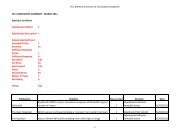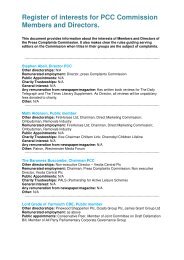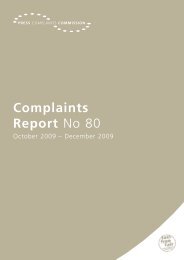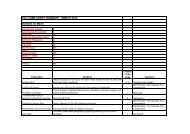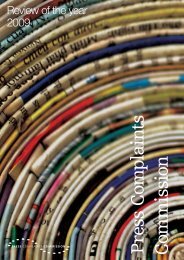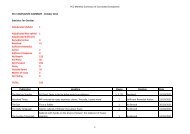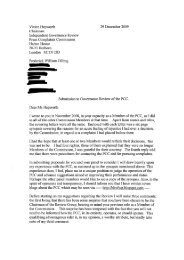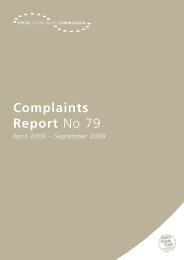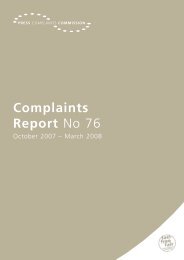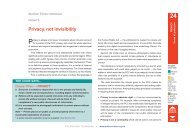2008 - Press Complaints Commission
2008 - Press Complaints Commission
2008 - Press Complaints Commission
Create successful ePaper yourself
Turn your PDF publications into a flip-book with our unique Google optimized e-Paper software.
SPECIAL REPORT –<br />
REPORTING OF SUICIDE<br />
CASE STUDY<br />
Using<br />
images<br />
in context<br />
A SUNDAY TIMES magazine article<br />
on the Bridgend suicides was illustrated<br />
with photographs of those involved set<br />
against a graphic depiction of a noose.<br />
Madeleine Moon MP complained about<br />
use of the graphic and republication of<br />
the photographs. The <strong>Commission</strong><br />
accepted that a view as to sensitivity was<br />
subjective but did not consider that the<br />
use of the images – given their context<br />
– raised a breach of the Code. Nor was<br />
there excessive detail about the method<br />
used. As such, the PCC did not uphold<br />
the complaint.<br />
LESSON The <strong>Commission</strong> has<br />
three tests: does the coverage<br />
break news of a death; does it<br />
treat it in a light-hearted way;<br />
and does it include gratuitous or<br />
gruesome detail? Newspapers<br />
should also be aware that the<br />
use of photographs, especially<br />
when accompanied by dramatic<br />
graphics, can cause considerable<br />
distress to families.<br />
ABOVE: Bridgend Open Day<br />
Continued from page 15<br />
there was a general lack of understanding<br />
about our powers and availability. We will<br />
address this in future by fostering greater<br />
awareness of our role, especially among<br />
police family liaison officers.<br />
Another lesson related to<br />
photographs taken from social networking<br />
sites. This case was perhaps the first that<br />
highlighted ethical issues about<br />
information crossing from personal<br />
websites into the mainstream media.<br />
Relatives felt they had no control over<br />
images which, in many cases, they had<br />
previously been unaware of. Each time<br />
there was a new death, republication<br />
made it difficult to move the grieving<br />
process on. We asked the media not to<br />
reuse pictures obtained in this way.<br />
There was further follow-up in the<br />
form of adjudicated complaints and a new<br />
Best Practice Note issued by the Editors’<br />
Code of Practice Committee (see opposite).<br />
Editors’ Code of Practice Committee:<br />
Briefing note on reporting of suicide<br />
Suicide: a sensitive issue<br />
Suicide has always been covered by the<br />
Code’s rules on intrusion into grief,<br />
stressing the need for sympathy and<br />
discretion and sensitivity in publication.<br />
But there is a dimension to reporting<br />
suicide that sets it apart from other<br />
tragedies: the inherent risk of ‘social<br />
contagion’. Research has demonstrated<br />
that media portrayals of suicide – as in<br />
news reports or fictional TV or films – can<br />
influence suicidal behaviour and lead to<br />
multiple imitative acts, particularly among<br />
the young. Instances of self-poisoning<br />
increased by 17% in the week after it was<br />
featured in a TV drama.<br />
In 2006, faced with real evidence that<br />
over-explicit reporting could lead to copycat<br />
cases, the Code Committee introduced a<br />
new sub-clause: When reporting suicide, care<br />
should be taken to avoid excessive detail of<br />
the method used. So editors face a twin test:<br />
they must both publish with sensitivity and<br />
avoid excessive detail.<br />
The Bridgend experience<br />
A series of more than 20 suicides of young<br />
people in and around Bridgend in South<br />
Wales thrust all this into the spotlight. Some<br />
politicians, police and parents blamed media<br />
speculation about possible links between the<br />
deaths for possibly triggering later cases.<br />
A PCC survey revealed a complex<br />
web of public anxieties in Bridgend that<br />
often went far beyond the scope of press<br />
self-regulation, embracing concerns about<br />
broadcasters and foreign media, and<br />
sometimes involving wider societal issues.<br />
These apart, the picture that emerged was<br />
less a case of repeated individual breaches<br />
of the Code, than a cumulative jigsaw<br />
effect of collective media activity, which<br />
became a problem only when the<br />
individual pieces were put together.<br />
While the Code covered many<br />
public concerns, it was clear that others<br />
might be more appropriately – and<br />
effectively – addressed not by overprescriptive<br />
rules but by editors modifying<br />
their activities voluntarily.<br />
Important areas of public<br />
concern where the Code<br />
already applies include:<br />
• Graphic images illustrating suicide<br />
methods were often upsetting to<br />
relatives and friends. Under the Code,<br />
such images would normally have to<br />
pass the ‘excessive detail’ test.<br />
• The cumulative effect of repeated<br />
media inquiries to family members also<br />
caused unintended distress. Here, too,<br />
the PCC can help by passing on ‘desist’<br />
messages via its arrangements for<br />
handling media scrums.<br />
• Glorification of suicide: Stories<br />
presented in a way likely to romanticise<br />
suicide could have a serious influence,<br />
especially on vulnerable young people.<br />
But, within the spirit of the Code, most<br />
coverage of this sort would again risk<br />
breaching the ‘excessive detail’ rule.<br />
Possible areas where<br />
editors might voluntarily<br />
mitigate the effects<br />
of legitimate<br />
publicity include:<br />
• Helpline numbers: When reporting<br />
the Bridgend deaths, many newspapers<br />
voluntarily published contact details of<br />
charities that aid people with suicidal<br />
feelings. This was widely welcomed as<br />
directing those most at risk – especially<br />
vulnerable young people – into the arms<br />
of those who could offer them most help.<br />
• Republication of photographs: Each<br />
new death often prompted reprinting of<br />
images of others who had taken their own<br />
life, adding to families’ distress. Sometimes<br />
it might be necessary, others not.<br />
• Publications of photographs without<br />
family consent: Using pictures supplied<br />
by friends or from social networking<br />
sites, without the close family’s consent,<br />
can cause unintentional distress.<br />
There can be no hard rules in such<br />
subjective areas. These and similar<br />
measures can only be discretionary.<br />
But the lessons of Bridgend are that,<br />
by bearing them in mind, editors faced<br />
with difficult judgments at critical<br />
times could avoid causing unintended<br />
offence or exposure to accusations<br />
of insensitivity.<br />
C A S E S T U D Y<br />
Omitting excessive<br />
information<br />
SEVERAL NEWSPAPERS published reports about a man who had killed himself with<br />
a chainsaw, giving details about how the implement had been positioned and activated.<br />
The <strong>Commission</strong> investigated the issue without a formal complaint and concluded that<br />
the published details were excessive and that the newspapers (many of which had only<br />
published the story online) had, therefore, breached Clause 5 (ii) of the Code. Whilst<br />
the newspapers argued that the information had been heard at inquest and provided<br />
by an agency, we ruled that this was not sufficient defence.<br />
LESSON The editing process is crucial. Care must be taken to remove<br />
excessive information prior to publication – both online and offline – even if<br />
that information has been heard during an inquest or has been provided by<br />
a news agency.<br />
C A S E S T U D Y<br />
Removing specific<br />
references<br />
A READER FELT that She magazine had included too much<br />
detail in an article on suicide. The article was a first person<br />
account written by the sister of someone who had taken<br />
his own life and referred specifically to how he had electrocuted<br />
himself. Accepting the merit of the complaint, the magazine<br />
introduced a more stringent compliance procedure, all staff<br />
were briefed on the Code and the issue was raised at an<br />
internal legal seminar.<br />
LESSON It is the editor’s responsibility to remove<br />
excessive detail about how the suicide was carried out.<br />
16 17




